Mazen Hasna
Compact Analytical Model for Real-Time Evaluation of OAM-Based Inter-Satellite Links
Jun 25, 2025Abstract:This paper presents an efficient analytical framework for evaluating the performance of inter-satellite communication systems utilizing orbital angular momentum (OAM) beams under pointing errors. An accurate analytical model is first developed to characterize intermodal crosstalk caused by beam misalignment in OAM-based inter-satellite links. Building upon this model, we derive efficient expressions to analyze and optimize system performance in terms of bit error rate (BER). Unlike traditional Monte Carlo-based methods that are computationally intensive, the proposed approach offers accurate performance predictions. This enables a substantial decrease in computation time while maintaining high accuracy, thanks to the use of analytical expressions for both crosstalk and BER. This fast and accurate evaluation capability is particularly critical for dynamic low Earth orbit (LEO) satellite constellations, where network topology and channel conditions change rapidly, requiring real-time link adaptation. Furthermore, we systematically design and evaluate asymmetric OAM mode sets, which significantly outperform symmetric configurations in the presence of pointing errors. Our results also reveal key insights into the interaction between beam divergence, tracking accuracy, and link distance, demonstrating that the proposed framework enables real-time optimization of system parameters with high fidelity. The analytical findings are rigorously validated against extensive Monte Carlo simulations, confirming their practical applicability for high-mobility optical wireless systems such as LEO satellite networks.
Physical Limits of Entanglement-Based Quantum Key Distribution over Long-Distance Satellite Links
Jun 25, 2025Abstract:Entanglement-based quantum key distribution (QKD) protocols, such as E91 and BBM92, offer strong information-theoretic security and are naturally suited for satellite-to-satellite QKD (SatQKD) links. However, implementing these protocols over long-distance inter-satellite free-space optical (FSO) channels poses critical physical-layer challenges that are not addressed in the existing literature. In particular, photon losses due to beam divergence, pointing errors, and background noise can severely degrade the key generation rate and quantum bit error rate (QBER), especially under narrow receiver field-of-view (FoV) constraints. This paper presents a comprehensive performance analysis of entanglement-based inter-satellite QKD, focusing on photon-level modeling and the impact of practical impairments. We develop analytical expressions for signal detection probabilities, background photon influence, multi-pair emissions, and QBER, incorporating key parameters such as link distance, transmitter tracking jitter, receiver misalignment, and photon pair generation rate. Simulation results reveal the nonlinear sensitivity of system performance to tracking error and FoV limitations, and highlight optimal parameter regimes that jointly maximize secret key rate while maintaining QBER below acceptable thresholds. The proposed model provides actionable design insights for reliable and efficient deployment of entanglement-based SatQKD systems.
Optimizing UAV Trajectory for Emergency Response Operations under Real 3D Environments: Integrating Priority Levels and LoS Constraints
Aug 14, 2024Abstract:Unmanned Aerial Vehicles (UAVs) have emerged as a critical component in next-generation wireless networks, particularly for disaster recovery scenarios, due to their flexibility, mobility, and rapid deployment capabilities. This paper focuses on optimizing UAV trajectories to ensure effective communication in disaster-stricken areas using terahertz (THz) links. We address specific challenges such as energy consumption, user priority levels, and navigating complex urban environments to maintain Line of Sight (LoS) connections amidst 3D obstacles. Our contributions include the development of a detailed modeling approach using online 3D map data, the formulation of an optimal trajectory optimization problem, and the proposal of a Genetic Algorithm (GA)-based method alongside an enhanced heuristic algorithm for faster convergence. Through 3D simulations, we demonstrate the trade-off between minimizing total service time and prioritizing higher-weight nodes, showing the impact of different priority weight factors on the trajectory time. The proposed algorithms are evaluated using real-world data from the West Bay area of Doha, Qatar, demonstrating their effectiveness in optimizing UAV trajectories for emergency response.
Modulating Retroreflector-based Satellite-to-Ground Optical Communications: Sensing and Positioning
Jan 17, 2024Abstract:This paper focuses on the optimal design of a modulated retroreflector (MRR) laser link to establish a high-speed downlink for cube satellites (CubeSats), taking into account the weight and power limitations commonly encountered by these tiny satellites. To this end, first, a comprehensive channel modeling is conducted considering key real channel parameters including mechanical gimbal error, fast steering mirror angle error, laser beamwidth, MRR area, atmospheric turbulence, and channel coherence time. Accordingly, a closed-form expression for the distribution of the received signal is derived and utilized to propose a maximum likelihood based method to sense and estimate the initial position of the satellite. Subsequently, the distribution of the distance estimation error during the sensing phase is formulated as a function of the laser beamwidth and the gimbal error, which enables us to fine-tune the optimal laser beamwidth to minimize sensing time. Moreover, using the sensing and initial satellite distance estimation, two positioning algorithms are proposed. To compare the performance of the proposed positioning method, we obtain the lower bound of the positioning error as a benchmark. Finally, by providing comprehensive simulations, we evaluate the effect of different parameters on the performance of the considered MRR-based system in both the sensing and positioning phases.
Terahertz Multiple Access: A Deep Reinforcement Learning Controlled Multihop IRS Topology
Mar 16, 2023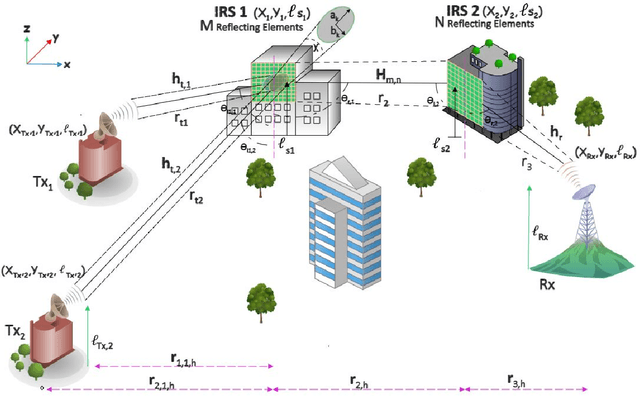
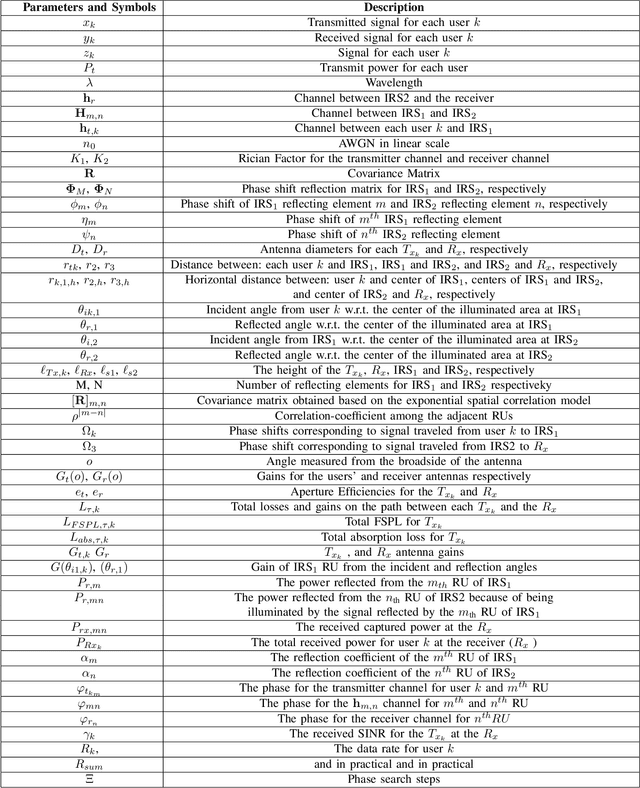
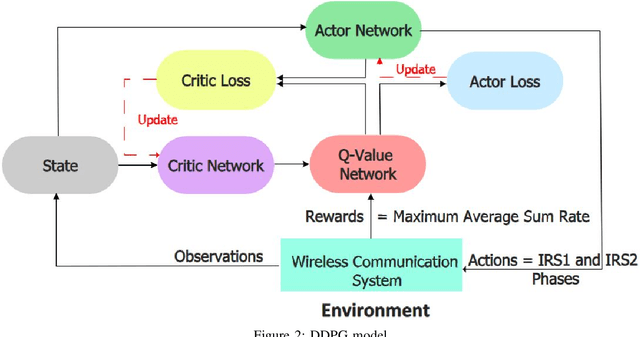
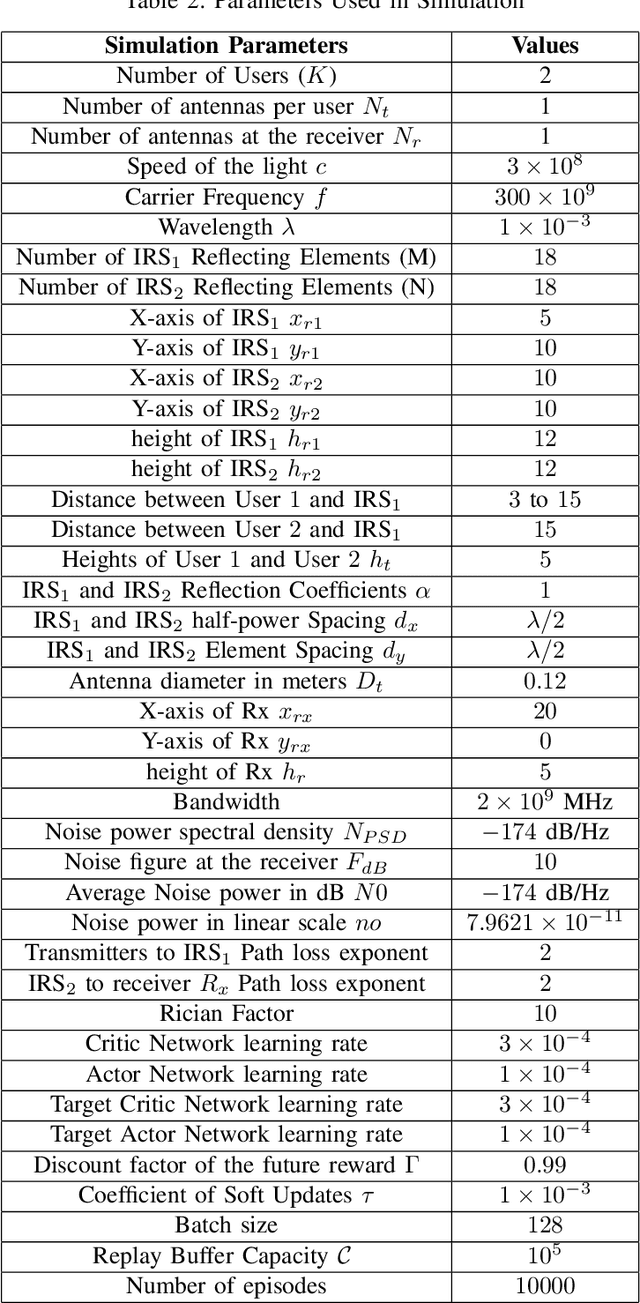
Abstract:We investigate THz communication uplink multiple access using cascaded intelligent reflecting surfaces (IRSs) assuming correlated channels. Two independent objectives to be achieved via adjusting the phases of the cascaded IRSs: 1) maximizing the received rate of a desired user under interference from the second user and 2) maximizing the sum rate of both users. The resulting optimization problems are non-convex. For the first objective, we devise a sub-optimal analytical solution by maximizing the received power of the desired user, however, this results in an over determined system. Approximate solutions using pseudo-inverse and block-based approaches are attempted. For the second objective, a loose upperbound is derived and an exhaustive search solution is utilized. We then use deep reinforcement learning (DRL) to solve both objectives. Results reveal the suitability of DRL for such complex configurations. For the first objective, the DRL-based solution is superior to the sub-optimal mathematical methods, while for the second objective, it produces sum rates almost close to the exhaustive search. Further, the results reveal that as the correlation-coefficient increases, the sum rate of DRL increases, since it benefits from the presence of correlation in the channel to improve statistical learning.
A General Model for Pointing Error of High Frequency Directional Antennas
Aug 30, 2022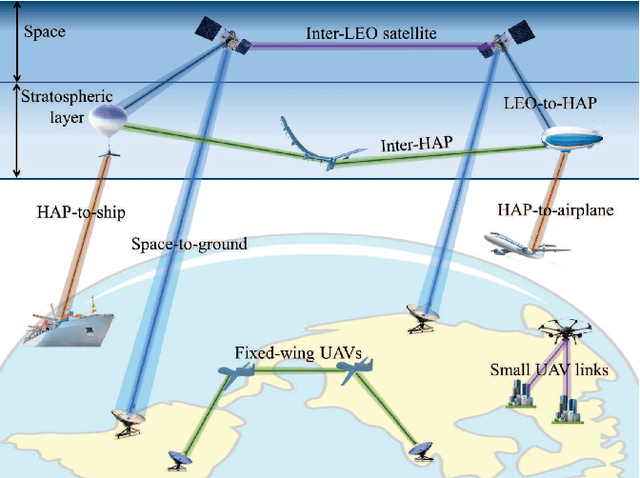
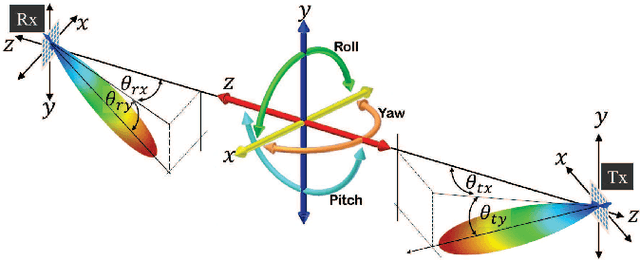
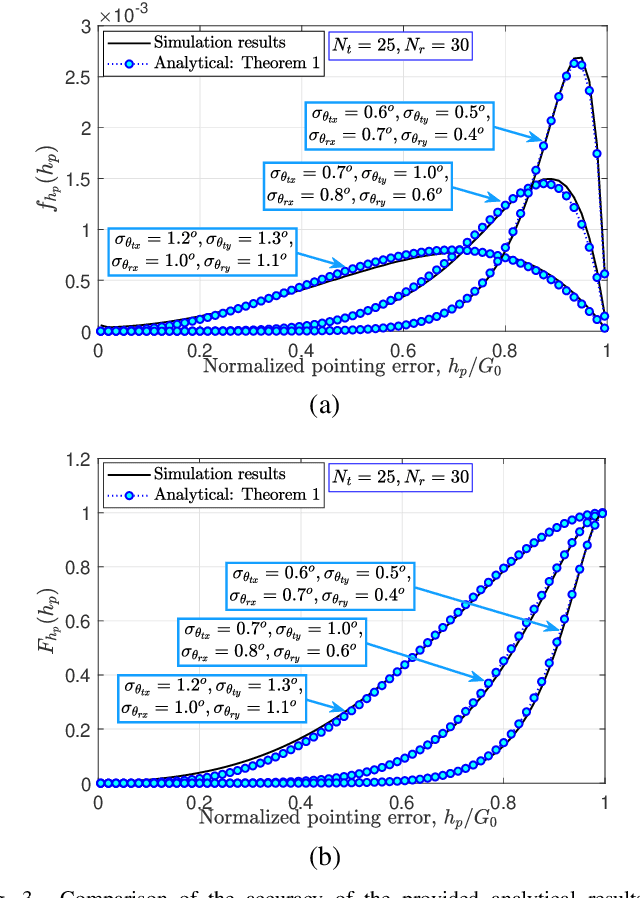
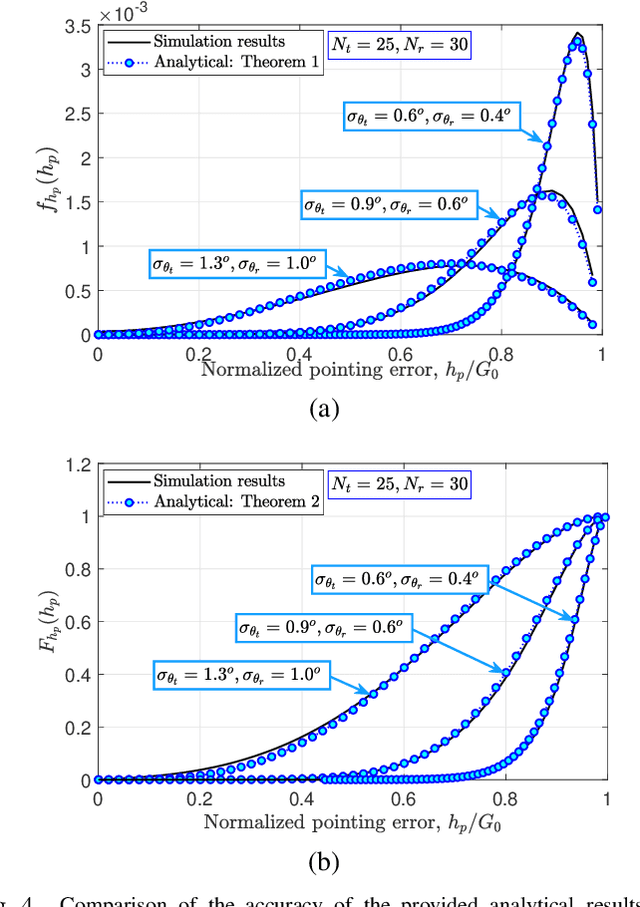
Abstract:This paper focuses on providing an analytical framework for the quantification and evaluation of the pointing error for a general case at high-frequency millimeter wave (mmWave) and terahertz (THz) communication links. For this aim, we first derive the the probability density function (PDF) and cumulative distribution functions (CDF) of the pointing error between an unstable transmitter (Tx) and receiver (Rx), that have different antenna patterns and for which the vibrations are not similar in the Yaw and Pitch directions. The special case where the Tx and Rx are both equipped with uniform linear array antenna is also investigated. In addition, using $\alpha-\mu$ distribution, which is a valid model for small-scale fading of mmWave/THz links, the end-to-end PDF and CDF of the considered channel is derived for all the considered cases. Finally, by employing Monte-Carlo simulations, the accuracy of the analytical expressions is verified and the performance of the system is studied.
Downlink Interference Analysis of UAV-based mmWave Fronthaul for Small Cell Networks
Aug 11, 2022
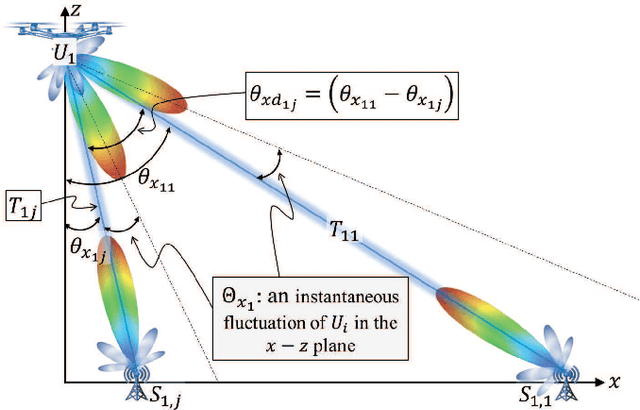
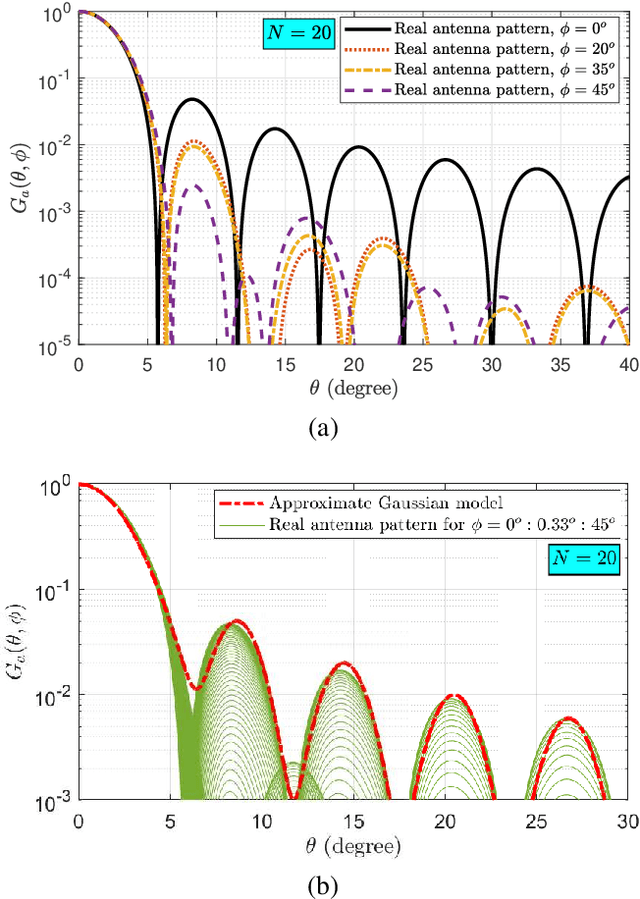
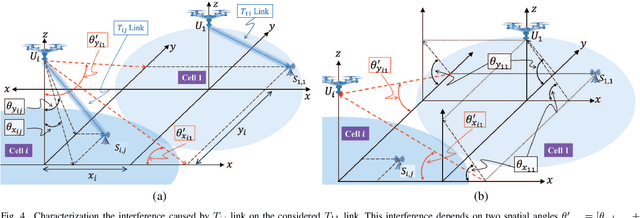
Abstract:In this paper, an unmanned aerial vehicles (UAV)-based heterogeneous network is studied to solve the problem of transferring massive traffic of distributed small cells to the core network. First, a detailed three-dimensional (3D) model of the downlink channel is characterized by taking into account the real antenna pattern, UAVs' vibrations, random distribution of small cell base stations (SBSs), and the position of UAVs in 3D space. Then, a rigorous analysis of interference is performed for two types pf interference: intra-cell interference and inter-cell interference. The interference analysis results are then used to derive an upper bound of outage probability on the considered system. Using numerical results show that the analytical and simulation results match one another. The results show that, in the presence of UAV's fluctuations, optimizing radiation pattern shape requires balancing an inherent tradeoff between increasing pattern gain to reduce the interference as well as to compensate large path loss at mmWave frequencies and decreasing it to alleviate the adverse effect of a UAV's vibrations. The analytical derivations enable the derivation of the optimal antenna pattern for any condition in a short time instead of using time-consuming extensive simulations.
Pointing Error Modeling of mmWave to THz High-Directional Antennas
Jun 21, 2022
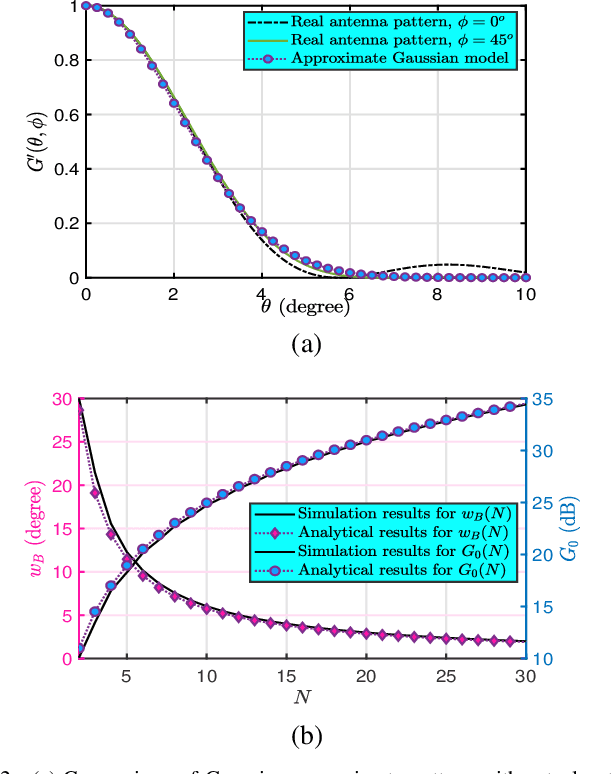
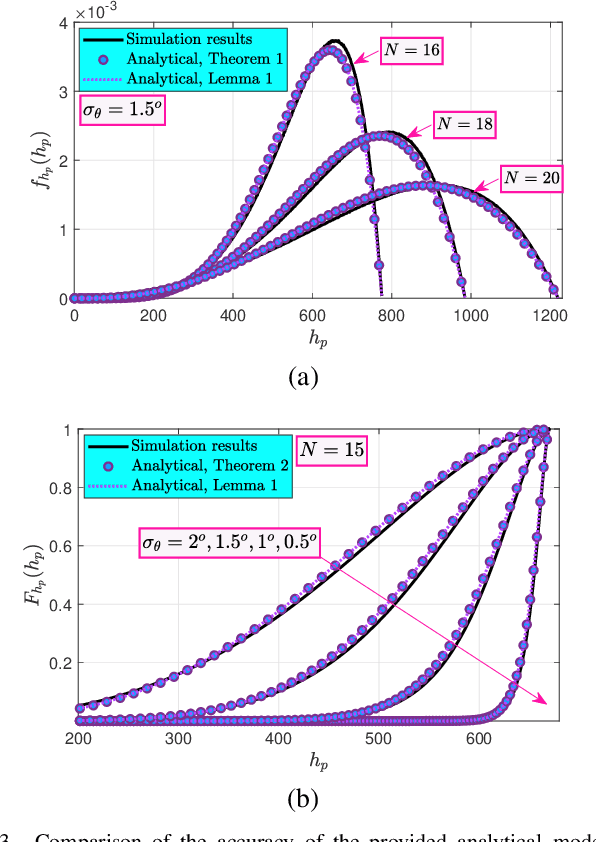
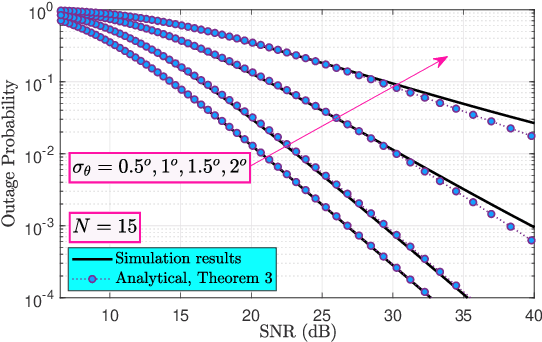
Abstract:This paper focuses on providing an analytical framework for the quantification and evaluation of the pointing error at high-frequency millimeter wave (mmWave) and terahertz (THz) communication links. For this aim, we first characterize the channel of a point-to-point communication link between to unstable transmitter (Tx) and receiver (Rx) and then, we derive the probability density function (PDF) and cumulative distribution functions (CDF) of the pointing error in the presence of an unstable Tx and Rx as a function of the antennas' pattern. Specifically, for the standard array antenna, a closed-form expression is provided for PDF of the pointing error, which is a function of the number of antenna elements. Moreover, a more tractable approximate model is provided for the CDF and PDF of pointing error. In addition, using $\alpha-\mu$ distribution, which is a common model for small-scale fading of THz links, the end-to-end PDF of the considered channel is derived and used to calculate the outage probability of the considered system. Finally, by employing Monte-Carlo simulations, the accuracy of the analytical expressions is verified and the performance of the system is studied.
 Add to Chrome
Add to Chrome Add to Firefox
Add to Firefox Add to Edge
Add to Edge